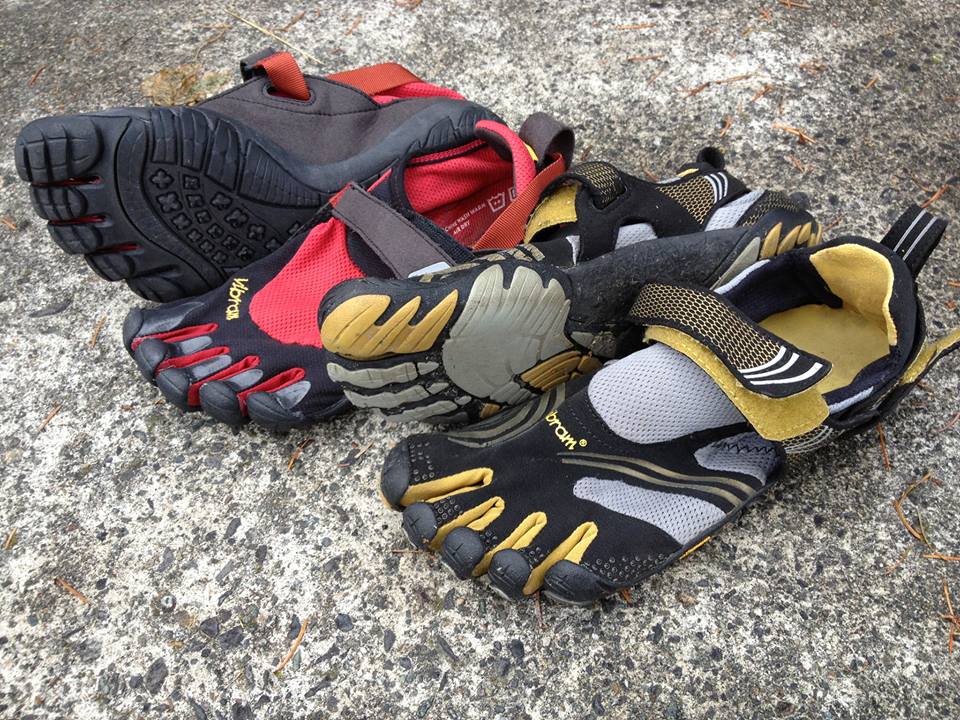By Takami Shirai, Michael Hsu and Anthony Chang
 Barefoot and “minimalist” running definitely has momentum. Christopher McDougall’s National Bestseller, Born to Run: A Hidden Tribe, Superathletes, and the Greatest Race the World Has Never Seen has sparked worldwide interest and inspired many to pursue barefoot running. Influential companies such as Nike, New Balance and Vibram have designed minimalist shoes that mimic the natural feel of barefoot running.
Barefoot and “minimalist” running definitely has momentum. Christopher McDougall’s National Bestseller, Born to Run: A Hidden Tribe, Superathletes, and the Greatest Race the World Has Never Seen has sparked worldwide interest and inspired many to pursue barefoot running. Influential companies such as Nike, New Balance and Vibram have designed minimalist shoes that mimic the natural feel of barefoot running.
Multinational corporations became firm advocates for barefoot and “minimalist” running and utilized research to suppport their persuasive marketing strategies. Controversy concerning the specific claims about the influence of barefoot and “minimalist” running on injury prevention has recently emerged. Let us help you make an informed decision about what is the best type of shoe for you. Here is some evidence surrounding barefoot and “minimalist” running.
Robbins and Hanna (1987) proposed that running shoes with supportive structures and absorbent cushioning suppressed sensory feedback and therefore increased the likelihood of lower extremity injuries. They recommended barefoot running as a possible solution to running-related injuries, but considering social norms, the researchers suggested shoe modifications to promote natural shock absorption. The “minimalist” shoe was born.
Lieberman et al. (2010) compared the gait of barefoot and shod runners. While barefoot runners typically landed on their forefoot first, shod runners displayed a rearfoot strike pattern (Lieberman et al., 2010). The forefoot strikers generated lower peak impact forces compared with rearfoot strikers (Lieberamn et al., 2010).
Nigg and Enders (2013) support the previous findings that landing during barefoot running occurs on the forefoot whereas heel landing is more prevalent in shod runners. However, a meta-analysis revealed that there is “no significant difference” between impact forces for individuals developing a stress fracture to the control group (Nigg & Enders, 2013, p. 5). Therefore, impact forces are not predictors of developing that common overuse running injury.
Another recent systematic review by Hall et al. (2013) supported that current research on barefoot running still lacks any conclusive evidence to make valid comparisons between barefoot and shod running – especially pertaining to ground reaction forces (GRF) and power absorption at the knee (Hall et al., 2013). All 18 studies reviewed were of low methodological quality, which prevents drawing definitive conclusions. Key weaknesses were the absence of investigator blinding, infrequent intervention randomization, small sample sizes, and a lack of evaluation following habituation.
Based on available evidence, we recommend the public use whichever running style or footwear they are most comfortable with. Injuries are typically multifactorial, thus, it is unlikely that the type of running shoe used is the sole predictor of injury. For example, someone with a previous running injury may benefit from adopting a barefoot running style as it likely reduces loading rates. However, there is also the potential to exacerbate the injury (e.g., if the individual has poor gait mechanics) (Murphy et al., 2013). Conversely, if an individual has had no previous injuries, then a transition to barefoot running may not be necessary. This may actually increase the likelihood of injury if the individual changes to a forefoot running pattern too suddenly. Currently, there is no conclusive evidence that barefoot running is superior to shod running in a healthy individual. Murphy et al. (2013) concludes that if the shod runner is not presently injured, they should follow the old colloquial phrase: ‘‘if it ain’t broke, don’t fix it.’’ As consumers of today’s ever-changing research landscape, we strongly urge people to choose a pair of runners that provides comfort in their strides.
*************************************************
Takami Shirai is an undergraduate student in the School of Kinesiology at the University of British Columbia. He is expected to graduate in May 2014 with a Bachelor’s Degree of Kinesiology and a Minor in Nutritional Science. He is passionate about working with special populations and aspires to become a physiotherapist.
Michael Hsu is a fourth year student at the University of British Columbia. He is currently working towards his Bachelor of Kinesiology in the Interdisciplinary Studies program. Upon graduation, his plans are to obtain a massage therapy license and work as registered massage therapist for athletic rehabilitation.
Anthony Chang is currently in his fourth year at the University of British Columbia. He is working his degree in Kinesiology in the Interdisciplinary Studies stream. He is looking to go into the clinical and health care field for rehabilitation with special populations.
References
Hall, J., Barton, C., Jones, P.R., & Morrissey, D. (2013). The Biomechanical Differences Between Barefoot and Shod Distance Running: A Systematic Review and Preliminary Meta-Analysis. Cham, ZG: Springer International Publishing Switzerland.
Lieberman, D. E., Venkadesian, M., Werbel, W. A., Daoud, A. I., D’Andrea, S., Davis, I. S., Ojiambo Mang’Eni, R. & Pitsiladis, Y. (2010). Foot strike patterns and collision forces in habitually barefoot versus shod runners. Nature, 463, 531-536. doi:10.1038/nature08723
Murphy, K., Currey J.C., Matzkin, E.G. (2012). Barefoot Running: Does It Prevent Injuries?. Cham, ZG: Springer International Publishing Switzerland.
Nigg, B., & Enders, H. (2013). Barefoot running – some critical considerations. Footwear Science, 5, 1-7. doi:10.1080/19424280.2013.766649
Robbins, S. E., & Hanna, A. M. (1987). Running-related injury prevention through barefoot adaptations. Medicine & Science in Sports & Exercise, 19, 148-156. Retrieved from http://www.ncbi.nlm.nih.gov/pubmed/2883551